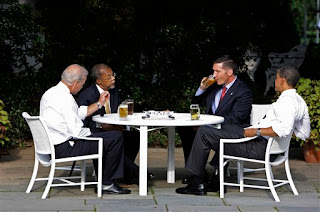 READ STORY HERE
READ STORY HERESurrounded by his embattled health care reform proposals, decidedly mixed economic data and a minor racial controversy the President has seen his approval numbers dip to the point where his administration might have to start taking notice. Although negative feelings aren’t being felt across the board to the same degree in which they plagued most of President Bush’s second term, “Obama Mania” has certainly subsided while the voices of opposition number greater and grow louder.
The cumulative average of ten recent polls taken since mid-July place President Obama’s approval rating at 55%. While this is still a positive number the media focus is all about momentum, and in terms of momentum 55% marks a sharp decline. It’s quite possible that the bottom has not been reached yet either. Gallup has Obama at a 52% approval rating with his negatives reaching 41% - both far and away the worst numbers of his young administration.
The news out of Rasmussen Reports is even worse President. Surveying “likely voters” instead of registered voters or general adults as most polls do, Rasmussen has the President’s approval at 48%. Furthermore, the number of those strongly disapproving of the job he is doing outnumber those who strongly approve by 12%, also the worse disparity yet for the Obama administration.
Lately bad news has proven easy to find and a difficult landmine to sidestep for the administration. Across the board polls show that at least a plurality of adults consider President Obama to have mishandled the racially tinged dispute involving the arrest of black Harvard professor Henry Louis Gates Jr. by white officer James Crowley. Obama admitted to have chosen his wording poorly and planned to have both men attend the White House for a casual outdoor discussion. Press Secretary Robert Gibbs was bombarded with questions recently about the issue and the President’s falling approval ratings, dismissing the latter as unimportant.
Surprisingly perhaps modest gains made by the stock market in recent weeks and the imminent confirmation of hand picked Supreme Court Judge Sotomayor to the Supreme Court have apparently done little to boost Obama’s favorability. Some columnists such as Dan Balz of the Washington Post and Katie Connolly of Newsweek question the validity of numbers as relating to an actual decline in support for the President however. Balz took note of a focus group of mildly dissatisfied but still optimistic independents. Connolly in her piece pointed towards a PR struggle and the mere perception of negativity over actual negativity toward the President and his policies.
Perhaps what these polls show most clearly is that Obama hasn’t been specific enough in his plans, especially while his opponents have been so explicit in their criticisms. He’s losing because he’s combating particulars with generalities. When respondents are answering questions about “Obama’s plan,” it’s still not even clear what that plan is. The president certainly hasn’t detailed it. In this debate, specifics will always prevail over abstractions, but fortunately for Obama, that’s not such a hard problem to remedy. – Katie Connolly (Newsweek)
Still it’s hard to ignore the anatomy of what makes up Obama’s declining overall approval ratings. The proof may just be in the pudding after all - some examples below.
* An equal number (46-46%) approve and disapprove of the way the President is handling health care policy – Time
* 41% of respondents disapproved of the way President Obama handled the Gates arrest compared to 29% who approved - Pew
* Just 39% approve of the way the President is handling the federal budget. That’s a ten-point drop in three months - AP-GFK
* By a margin of 49-47%, more adults disapprove of the way President Obama is handling the economy than approve – USA Today
* An even number of those (24% ea.) are very confident or not confident at all that Obama can “bring about real change to the way things are done in Washington” - Diageo/Hotline
* Since entering office only 32% of voters think things have gotten better under Obama. 30% say they have gotten worse, and 37% say they’ve stayed the same – Quinnipiac
* In the month of July consumer confidence has been at an average index level of (-50) – ABC News













